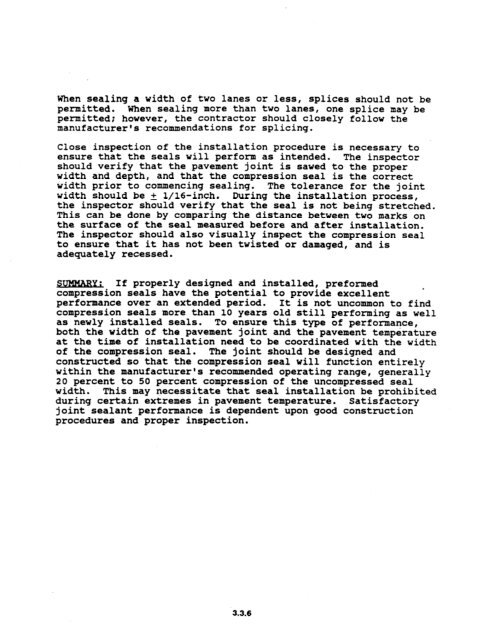chapter 3 rigid pavement - DOT On-Line Publications - Department ...
chapter 3 rigid pavement - DOT On-Line Publications - Department ...
chapter 3 rigid pavement - DOT On-Line Publications - Department ...
You also want an ePaper? Increase the reach of your titles
YUMPU automatically turns print PDFs into web optimized ePapers that Google loves.
When sealing a width of two lanes or less, splices should not be<br />
permitted. When sealing more than two lanes, one splice may be<br />
permitted; however, the contractor should closely follow the<br />
manufacturer's recommendations for splicing.<br />
Close inspection of the installation procedure is necessary to<br />
ensure that the seals will perform as intended. The inspector<br />
should verify that the <strong>pavement</strong> joint is sawed to the proper<br />
width and depth, and that the compression seal is the correct<br />
width prior to commencing sealing. The tolerance for the joint<br />
width should be + l/16-inch. During the installation process,<br />
the inspector should verify that the seal is not being stretched.<br />
This can be done by comparing the distance between two marks on<br />
the surface of the seal measured before and after installation.<br />
The inspector should also visually inspect the compression seal<br />
to ensure that it has not been twisted-or damaged,-and is<br />
adequately recessed.<br />
.<br />
s-y. If properly designed and installed, preformed<br />
compression seals have the potential to provide excellent<br />
performance over an extended period. It is not uncommon to find<br />
compression seals more than 10 years old still performing as well<br />
as newly installed seals. To ensure this type of performance,<br />
both the width of the <strong>pavement</strong> joint and the <strong>pavement</strong> temperature<br />
at the time of installation need to be coordinated with the width<br />
of the compression seal. The joint should be designed and<br />
constructed so that the compression seal will function entirely<br />
within the manufacturerls recommended operating range, generally<br />
20 percent to 50 percent compression of the uncompressed seal<br />
width. This may necessitate that seal installation be prohibited<br />
during certain extremes in <strong>pavement</strong> temperature. Satisfactory<br />
joint sealant performance is dependent upon good construction<br />
procedures and proper inspection.<br />
3.3.6
















